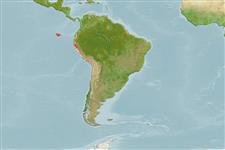Common names from other countries
>
Eupercaria/misc (Various families in series Eupercaria) >
Labridae (Wrasses)
Etymology: Semicossyphus: Greek, semi = half + Greek, kossyphos, -ou = a kind of fish (Ref. 45335).
More on author: Jenyns.
Environment: milieu / climate zone / depth range / distribution range
Écologie
marin récifal; profondeur 3 - 100 m (Ref. 11295). Tropical
Southeast Pacific: Ecuador to central Peru, and Galapagos Islands.
Taille / Poids / Âge
Maturity: Lm ? range ? - ? cm
Max length : 70.0 cm TL mâle / non sexé; (Ref. 11295); poids max. publié: 4.0 kg (Ref. 11295)
Description synthétique
Clés d'identification | Morphologie | Morphométrie
Épines dorsales (Total) : 12; Rayons mous dorsaux (Total) : 10; Épines anales: 3; Rayons mous anaux: 12.
Caught in both shallow and deep waters. Its strong dentition makes it an opportunistic predator, even of hard-shelled benthos as shown by its stomach contents of coarse calcareous remains and detritus (Ref. 11295).
Life cycle and mating behavior
Maturities | Reproduction | Spawnings | Egg(s) | Fecundities | Larves
Oviparous, with distinct pairing during breeding (Ref. 205).
Merlen, G., 1988. A field guide to the fishes of Galapagos. Wilmot Books, London, England 60 p. (Ref. 5590)
Statut dans la liste rouge de l'IUCN (Ref. 130435)
CITES (Ref. 128078)
Not Evaluated
Menace pour l'homme
Harmless
Utilisations par l'homme
Pêcheries: d'intérêt potentiel
Outils
Articles particuliers
Télécharger en XML
Sources Internet
Estimates based on models
Preferred temperature (Ref.
115969): 16.2 - 23.1, mean 19 (based on 22 cells).
Phylogenetic diversity index (Ref.
82804): PD
50 = 0.6250 [Uniqueness, from 0.5 = low to 2.0 = high].
Bayesian length-weight: a=0.00871 (0.00507 - 0.01497), b=3.04 (2.89 - 3.19), in cm Total Length, based on LWR estimates for this species & (Sub)family-body (Ref.
93245).
Niveau trophique (Ref.
69278): 4.2 ±0.2 se; based on diet studies.
Résilience (Ref.
120179): Faible, temps minimum de doublement de population : 4,5 à 14 années (Preliminary K or Fecundity.).
Fishing Vulnerability (Ref.
59153): Moderate to high vulnerability (48 of 100).
